About Japanese ingredients and substitutions
[Updated to add Substitution section.]
See also: Sake and mirin redux etc.
I haven't exactly counted it up, but of the thousands of comments left on Just Hungry, not to mention Just Bento, probably at least a quarter are questions about ingredients or ingredient substitutions. So I thought I might put down what my criteria are for what kind of ingredients I choose to feature in the recipes on either site, especially when it comes to Japanese recipes. [Update added on August 15th, 2008]: I've also added some suggested, and acceptable, substitutions.
Can I get a hold of it?
In case you didn't know, at the moment I live in a country with a fairly miniscule Japanese expat or immigrant population (the last I heard there were less than 2000 Japanese people living in the Zürich area). There is only one real Japanese grocery store near me, and it is quite small with a limited selection of products. There's also an equally small (though slightly better stocked) Korean grocery store, and a couple of Chinese grocery stores. (See Where I shope for Japanese/Asian ingredients in Zürich.) I supplement what I can get locally by placing an order with Japan Centre a few times a year.
My point is, that what I can get is fairly limited compared to many people, though more generous than others. So by sticking to what I can get here, I think that I'm in a good middle ground for people trying to cook anything Japanese. If you live in a region (e.g. most of California, New York City, or Hawaii) with big Japanese expat/immigrant populations, you have a much bigger selection available to you than I do!
(My mom also sends me things from Japan periodically, but I do not include the more exotic things in the recipes here, though I might mention then in passing.)
Is it available by mailorder?
I also periodically check to see if certain ingredients are available online. Some online merchants don't have very comprehensive listings on their web sites, but by emailing them they can tell you if they have something in stock.
Where to look for Japanese ingredients
In order of the likelihood of finding Japanese ingredients:
- Japanese grocery stores, including online stores. This is obvious. Please consult the Worldwide Japanese grocery store list for your area, and go to your nearest store to see what they have! That's the best way to get acquainted with unfamiliar ingredients.
- Korean grocery stores. A lot of Japanese ingredients are used in Korean cooking.
- Chinese grocery stores and general Asian grocery stores. Chinese grocery stores tend to stock less Japanese ingredients than Korean grocery stores, but you can still find a lot of things.
- Health food stores, including online stores. Many dry and/or vegan ingredients, such as rice flour, kuzu powder, agar-agar, miso and so on can be found at health food stores.
- South East Asian grocery stores (Thai, etc.) These stores don't stock Japanese ingredients per se, but some of the fresh product and things can be used.
- South Asian grocery stores (Indian, Sri Lankan, etc.) These can be a surprisingly good source for 'exotic' vegetables and such that are used in Japanese cooking.
Is it a widely used ingredient in Japanese cooking?
In general, I try to stay away from any ingredient that might be considered to be too regional or esoteric in Japan, and stick to ingredients that are likely to be in any Japanese kitchen.
Is the recipe something that is normally made in Japan?
When I do traditional Japanese recipes here, I try to stick to ones that are commonly made in Japanese homes (vs. something exotic, regional or so complicated it's only available in restaurants).
The exception to this rule is when I try to make something that is readily available in Japan, but not necessarily elsewhere. An example of this is really fresh tofu. The hard work required is worth it for the results.
Ingredient substitutions
In certain cases, you can make substitutions without a problem. I try to include substitution recommendations whenever possible, or when I am fairly sure it would work. For instance, many Japanese recipes call for katokuriko (片栗粉)which is a flour made from potato starch, but this is hard to get outside of Japan in most places. Cornstarch (or cornflour) has a very similar texture and performs the same function, so that is an easy substitute. Using honey or syrup instead of maple syrup will change the flavor a bit but also works.
In some cases though there is no substitution. If you are making kuzumochi, you really can't use anything other than kuzu powder if you want the same texture.
Sometimes you just need to try out a substitution to see if it works. For instance, when I call for a specific rice flour like shiratama-ko or joushinko, but you can't get it, try substituting a rice flour you can get and see how it goes. (I 've made rice dumplings with red rice flour from Sri Lanka, and it turned out fairly well.) The worst that can happen is that you end up with an inedible dish that you have to throw away, but that's not the end of the world. Don't be afraid of making mistakes!
Some acceptable substitutions
[This section added on August 15, 2008]
- Mirin and sake. I think more people ask about substitutes for these two ingredients than anything else put together. Both are alcoholic beverages (though mirin is never drunk and is only used in cooking). Mirin is stronger and sweeter than sake. Sake can be used as a substitute for mirin (with an added pinch of sugar), and vice versa. If you cannot get a hold of either, you can use sweet sherry or Chinese shiaoxing wine. If you cannot use alcohol for religious or other reasons, even though most of the alcohol will evaporate after cooking, just leave it out - it will affect the flavor, but there's no reasonable non-alcoholic substitute that I can think of. See also: The role of alcohol, onion and garlic in Japanese meat dishes (also applies to fish dishes in many cases) (Vinegar is not a good substitute. Vinegar makes things sour. I can't believe there are people saying that vinegar is a substitute for sake. Is vinegar a good substitute for wine in a recipe? Please.) Mirin style seasoning or mirin choumiryou (example here) has less than 1% alcohol content, so it can be used as a mirin substitute in terms of flavor. However, mirin style seasoning often has additives like MSG and sugar, so I'm not a fan of it. If you do leave out mirin from a recipe, you can add a bit of (or more) sugar to the recipe to compensate for the sweetness at least.
- Japanese-style or sushi rice. Keep in mind that 'sushi rice' is a name given by non-Japanese sellers to Japanese style or japonica medium grain rice. Medium-grain Italian rices that are used for risotto, such as vialone and arborio, are acceptable substitutes for Japanese rice; long grain rices including basmati and jasmine rice are not.
- Dashi stock. Japanese stock is usually made from kombu seaweed, dried bonito flakes (katsuobushi), dried fish called niboshi, or a combination of all or two of these. (See basic dashi recipe.) You may find it difficult to find these ingredients, or they may be too expensive. Powdered or granular dashi stock is similar to stock cubes, and can be used instead of made-from-scratch dashi; keep in mind that dashi granules are saltier and often contain MSG. See also vegan dashi stock made with dried shiitake mushrooms and kombu seaweed. If you can't get a hold of any of these, you can use a basic vegetable stock instead - it won't taste that Japanese but it's better than plain water at least!
- Miso and soy sauce. There are no substitutes for these. As to whether you should stick to Japanese soy sauce or use other kinds - I do believe that Japanese soy sauce tastes quite different from, say, Chinese soy sauce, but your palate may not be able to detect a big difference. Kikkoman is the most famous Japanese brand, and is available worldwide.
- Japanese tonkatsu sauce or okonomiyaki sauce, or "bulldog" sauce. Bulldog is the brand name of a popular line of barbeque-type sauces that are used in a lot of dishes, from panfried noodles (yakisoba) to deep fried pork cutlets (tonkatsu) , okonomiyaki, takoyaki and more. If you're in the U.S., you can use A-1 Steak Sauce, maybe tempered with a little added sugar and/or ketchup. Elsewhere, you can use Worcestershire sauce for the flavor if not the texture.
- Rice vinegar. White balsamic vinegar is the best substitute, but that's rather more exotic I think than rice vinegar! You can use also use a mild white wine vinegar instead, with a pinch of sugar to mellow it out.
In the vast majority of recipes here on Just Hungry as well as on Just Bento, I try to stick to these flavoring ingredients, plus universal ones like salt, pepper and sugar, so hopefully you won't run into too many problems around here at least.
Are there any other ingredients you'd like to know possible substitions for? Let me know in the comments.
See also
- Essential Japanese ingredients
- Essential equipment for Japanese cooking
- A dozen Japanese herbs and vegetables to grow
Kouya Dofu or Kohya Dofu, Freeze Dried Tofu
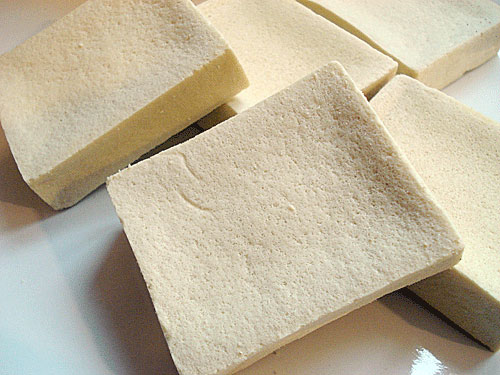
I've talked a little about kohya dofu or kouya dofu (高野豆腐)in the past, but I thought I'd describe it in detail so that I can refer back to it when I use this very versatile Japanese pantry staple in recipes.
Kouya dofu is freeze dried tofu. It's a long lasting pantry staple of most Japanese households. It comes in plastic packaging, usually 5 to a pack, like so:
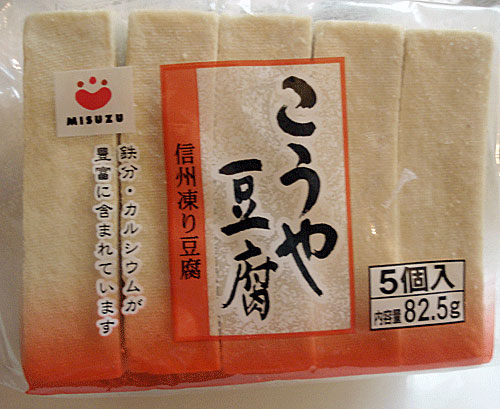
Each square is about the size of a business card, and about 1cm or 1/2 inch or so thick. Each kouya dofu square is about 90 calories. They look like dehydrated squares of bread, or one of those sponges that you soak in water to reconstitute and use. The packets require no refrigeration.
Indeed, it is a sponge - a block of tofu that's been reduced to its cell structure. It's a very old traditional preserved food, that probably got invented by accident when someone left out some tofu in the winter and it froze solid. It's made by repeatedly freezing and thawing tofu, until all the moisture can be extracted.
Usually, kouya dofu is used by reconstituting it first. The easiest way is to soak it for a while in boiling water to cover. When the water has cooled down enough for the tofu to be taken out and genty squeezed, it's ready to use. It swells up to about 3-4 times its original size.
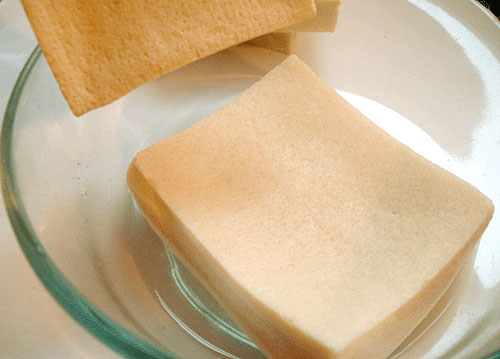
From here, you can just cut it up and use it in soups or stews. You can also marinate it. It has a more dense and firm texture than regular tofu, and like regular tofu it soaks up any flavor it is soaked or cooked in. It's usually stewed in a standard japanse soy sauce - mirin - sake - dashi - sugar mixture.
Here I've cooked some reconstituted kouya dofu in the same way that I cooked frozen tofu cutlets, to make kouya dofu nuggets. But I didn't have to take the time to freeze and defrost regular tofu. The results are much 'meatier' than nuggets made with frozen regular tofu. You might even be able to fool some unsuspecting people into think it's some sort of meat....
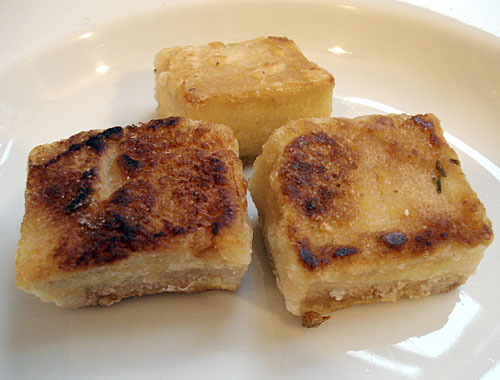
Another interesting way of using kouya dofu is to turn it into a powder by grating it or whizzing it in a food processor. The powder can be used instead of breadcrumbs, as a filler or binder in burgers and meatballs. This can be a good thing for celiacs and gluten intolerant people. The spongy texture soaks up any excess moisture and flavors. And of course, it provides and extra protain boost.
In Japan, kouya dofu is very cheap. Outside of Japan it can be more expensive, but the packet of 5 in the photo above was only $1.99 at Nara Foods in Port Washington, Long Island. So, look for it next time you are in a Japanese grocery store and give it a try, especially if you or someone you cook for has gluten allergies, or are vegan or vegetarian.
Filed under: japanese ingredients vegetarian tofu veganLooking at rice
(I've updated this very popular post with some info about germ rice (haiga-mai) and sprouted brown rice (hatsuga genmai). In case you missed it the first time around, here it is again in your RSS reader and on the front page.)
Rice is a big part of my food life. While I do like other kinds of carbohydrates, especially good bread and pasta, rice is definitely my favorite.
There are so many different kinds of rice though. Even if one leaves out the rather more exotic kinds like red rice from the Camargue, American wild rice (which is not actually a rice but a kind of grain) or black rice (kokumai), I usually have on hand several different kinds of rice, each with a different use. Here are the ones I have in the pantry right now that I use in everyday cooking.
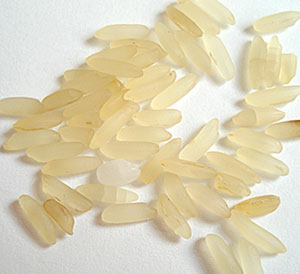 This is the long grain, parboiled rice, the kind that is most commonly used in European and American cooking. The grains don't stick together, for that separate, 'fluffy' texture that American/UK cookbooks find desirable. To me this is the most boring kind of rice with little character of its own. Nevertheless it is the least expensive kind of rice usually, and has its uses. I use this for rice dishes that have a lot of added flavor, like pilafs or fried rice. It can not be used as a substitute for japonica rice in most traditional Japanese dishes, since it is it not sticky enough.
This is the long grain, parboiled rice, the kind that is most commonly used in European and American cooking. The grains don't stick together, for that separate, 'fluffy' texture that American/UK cookbooks find desirable. To me this is the most boring kind of rice with little character of its own. Nevertheless it is the least expensive kind of rice usually, and has its uses. I use this for rice dishes that have a lot of added flavor, like pilafs or fried rice. It can not be used as a substitute for japonica rice in most traditional Japanese dishes, since it is it not sticky enough.
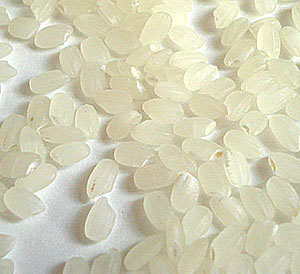 This is Japanese-style rice, or uruchi-mai - the kind of rice I talk about the most on this site. It is also sold as medium grain rice, or sushi rice. It's the rice to use for almost any kind of Japanese dish, including the all-important sushi and onigiri. The rice grains cling together without being mushy when properly cooked. This rice must be polish-washed to bring out its best flavor, as I have previously described. The best kinds of this rice have a translucent quality and have clean, rounded grains. As you can see, the grains are rounder compared to long-grain rice.
This is Japanese-style rice, or uruchi-mai - the kind of rice I talk about the most on this site. It is also sold as medium grain rice, or sushi rice. It's the rice to use for almost any kind of Japanese dish, including the all-important sushi and onigiri. The rice grains cling together without being mushy when properly cooked. This rice must be polish-washed to bring out its best flavor, as I have previously described. The best kinds of this rice have a translucent quality and have clean, rounded grains. As you can see, the grains are rounder compared to long-grain rice.
A variation of white uruchimai is haigamai (germ rice, 胚芽米). It's hulled and polished white rice with the germ left intact. This is a bit more nutritious than regular white rice. This is getting more available at Asian/Japanese groceries.See this excellent tutorial on Instructables for how to sprout brown rice.
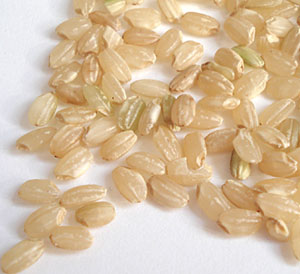 This is gen-mai, the brown version of uruchi-mai. It requires more water and a longer cooking time than the polished version. If you are in the market for a new rice cooker you may want to look for one that can cook brown rice. I've been eating more of this instead of the polished rice recently. Since the bran that is on brown rice contains oils that can turn rancid, it should be as fresh as possible. (Update: how to cook brown rice in a pot on the stovetop.)
This is gen-mai, the brown version of uruchi-mai. It requires more water and a longer cooking time than the polished version. If you are in the market for a new rice cooker you may want to look for one that can cook brown rice. I've been eating more of this instead of the polished rice recently. Since the bran that is on brown rice contains oils that can turn rancid, it should be as fresh as possible. (Update: how to cook brown rice in a pot on the stovetop.)
One way to process brown rice, which is supposed to make it much more nutritious, is to let it germinate or sprout. This turns it into hatsuga genmai (literally, "sprouted brown rice", 発芽玄米, also known as GBR in health-food/vegan circles). To sprout rice on your own, soak it in lukewarm water for 24 hours, and keep it in a warm place (I keep mine on top of the hot water tank). At the end of the 24 hours, you may see the end of the grains are splitting a bit, and evena tiny little white root peeking out - that means it's sprouted. If it hasn't sprouted yet, rinse the grains and cover again with lukewarm water. If it still hasn't sprouted by the end of another 24 hours, it probably never will, so you can just cook it before the grains start fermenting actively. Since the grains have been soaked for so long you can cook it as you would white rice (in a rice cooker for example). It is softer and supposed to be easier to digest than regular brown rice.
You can also purchase sprouted rice - look in health food stores.
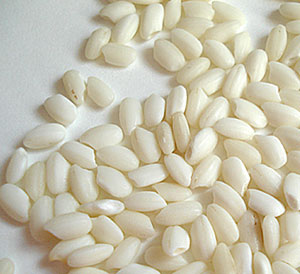 This is mochi-mai, or mochi rice, otherwise called sweet rice, short-grain rice, or sticky rice. The grains are not really that much shorter than the "medium-grain" uruchi-mai above but as you can see, the grains look quite different. The are opaque and white rather than transculent. This is beaten and kneaded to make glutinous mochi cakes, used to make osekihan (red rice with beans), or used for some sweets.
This is mochi-mai, or mochi rice, otherwise called sweet rice, short-grain rice, or sticky rice. The grains are not really that much shorter than the "medium-grain" uruchi-mai above but as you can see, the grains look quite different. The are opaque and white rather than transculent. This is beaten and kneaded to make glutinous mochi cakes, used to make osekihan (red rice with beans), or used for some sweets.
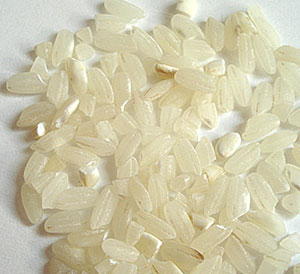 This is vialone rice from Italy. I use this or arborio rice for making risotto. It actually looks quite similar to uruchi-mai or japonica rice. These medium grain Italian rices can, a pinch, be used instead of Japanese rice. This is useful to know if you live in an area where vialone, arborio and other Italian rice varieties are cheaper than Japanese rice (which is certainly the case in Switzerland...we are a lot closer to Italy than to Japan after all). The reverse holds true too - if you have more or easier access to Japanese rice than arborio, vialone or carnaroli, you can use that, unrinsed, for risotto. When used for Italian dishes rice is not rinsed, since the powder that clings to the grains is the substance that makes risotto creamy.
This is vialone rice from Italy. I use this or arborio rice for making risotto. It actually looks quite similar to uruchi-mai or japonica rice. These medium grain Italian rices can, a pinch, be used instead of Japanese rice. This is useful to know if you live in an area where vialone, arborio and other Italian rice varieties are cheaper than Japanese rice (which is certainly the case in Switzerland...we are a lot closer to Italy than to Japan after all). The reverse holds true too - if you have more or easier access to Japanese rice than arborio, vialone or carnaroli, you can use that, unrinsed, for risotto. When used for Italian dishes rice is not rinsed, since the powder that clings to the grains is the substance that makes risotto creamy.
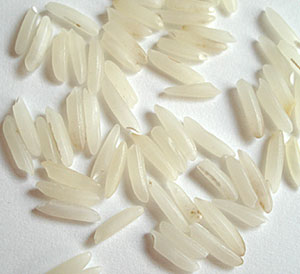 The final kind of rice that is a staple in our house is basmati rice. It has the longest grain of all, and a translucent appearance. It also has a a distinctive sort of spicy aroma, which matches spicy dishes perfectly. I keep this on hand of for Indian and Thai type dishes. I often have Thai 'perfume' or 'jasmine' rice on hand too, which is quite similar in cooking qualities. Neither basmati or jasmine rice can be used successfully in traditional Japanese dishes such as onigiri or sushi, since they are not sticky enough.
The final kind of rice that is a staple in our house is basmati rice. It has the longest grain of all, and a translucent appearance. It also has a a distinctive sort of spicy aroma, which matches spicy dishes perfectly. I keep this on hand of for Indian and Thai type dishes. I often have Thai 'perfume' or 'jasmine' rice on hand too, which is quite similar in cooking qualities. Neither basmati or jasmine rice can be used successfully in traditional Japanese dishes such as onigiri or sushi, since they are not sticky enough.
See also
Filed under: japanese ingredients riceLooking at tofu

(Periodically I like to dust off an article from the vast Just Hungry archives, give it a little facelift, and present it on the front page again. I wrote this guide to tofu back in September 2008. I think it will answer most, if not all, your questions about Japanese-style tofu and related products. Enjoy!
There are several tofu recipes both here in Just Hungry as well as on Just Bento, and I've even shown you how to make your own tofu from scratch. However, up until now I have never really tried to explain the differences between types of tofu, when to use them and how to store them. Well now is the time to fix that.
Fried tofu type 1: Aburaage

Aburaage (油揚げ)is deep fried tofu, where almost none of the soft white tofu remains. It's also called tofu skin or tofu pocket sometimes. When the tofu is deep fried, an air pocket is formed inside which can be stuffed, as in inarizushi or eggs in treasure bags. Besides stuffing it, you can use aburaage sliced up and put into soups or stir-fries, gently cooked whole in a broth as in kitsune udon, and more.
To get rid of the excess oil on the surface, blanch aburaage in boiling water for a couple of minutes, then drain away. To loosen it up so that it's easier to stuff, roll a round chopstick over the surface several times after blanching to loosen it up, then cut open.
The best way to store aburaage for longer than a few days is to freeze it. (The bag in the photo is actualy frozen.)
Japanese aburaage is always a rectangular sheet, but you can get small puffs or squares in Chinese markets.
Note: Don't confuse aburaage with canned (or packaged) inarizushi (or 'bean bag' sushi) skins, which have been cooked in a sweet-salty sauce. That is just one way to prepare aburaage. The canned inarizushi skins do tend to be rather high in salt, sugar and MSG, though they are very convenient to use. See how to make inarizushi from scratch, using plain aburaage.
Fried tofu type 2: Atsuage or namaage

Atsuage (厚揚げ)or namaage (生揚げ)is a block of tofu that has been slowly fried in oil until it forms a slightly crinkly pale brown skin. It's stil white tofu inside though, unlike aburaage. You can get rid of the excess oil on the surface just like with aburaage, by blanching it in boiling water. Aburaage is a very versatile food, that can be pan-fried or grilled like a steak, cut up and used in stir-fries or stewed, put into soups and so on. I like using aburaage in bento recipes a lot - because it has less moisture than non-fried tofu, it keeps longer.
The two main types of plain tofu
Finally we get to plain tofu. Plain tofu can be divided into two main types: silken or kinugoshi (絹ごし), and firm or pressed. In Japanese firm tofu is called momen (木綿)or cotton tofu. Here are a block of each: silken on the left, and firm/cotton on the right.
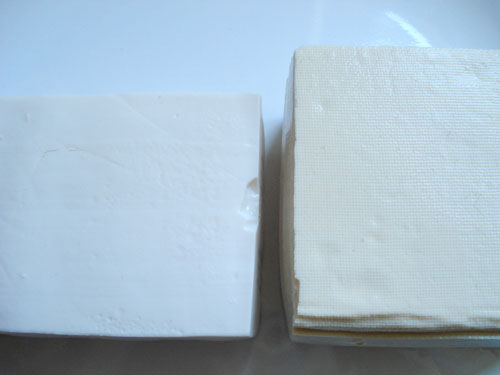
Here are the blocks from the side:
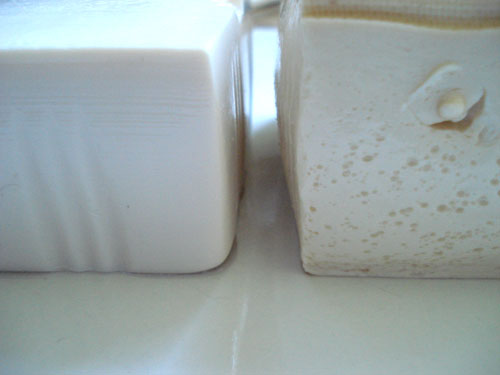
As you can see, the silken tofu is smoother and more watery, while the firm/cotton tofu is well, firmer and denser. Since silken tofu is much softer (higher water content), it is harder to handle if you want the tofu pieces to not fall apart. So if you are a tofu beginner and you want to use it on stir-fries or things like bacon wrapped tofu, you will want to use firm tofu. Firm tofu is less liable to fall apart, especially if you drain off the water a bit. Some recipes call for extracting even more water from the tofu (see using tofu for bento friendly recipes). On the other hand, silken tofu is more suited for recipes that call for it to be pureed, such as quick tofu pudding and baked squash and apple pudding, or in smoothies. I prefer silken tofu in miso soup, though firm is fine too.
Some other tofu types not pictured here
I don't have these on hand so pictures are missing...
Yaki dofu (焼き豆腐)is firm tofu that's been grilled on the outside, giving it a nice flavor.
Kouya dofu (高野豆腐)is freeze-dried tofu that is sold in the dried food section. It looks like little dried beige sponges. This is reconstituted in water before stewing. It can be a good pantry staple because it keeps indefinitely. Update: All about kouya dofu
Yuba (湯葉) is a Kyoto speciality. Thin films of tofu are scooped off the top of vats of warm soy milk. It's available in dried form and is usually used in soups and such. Fresh yuba made from fresh warm soy milk is considered a great delicacy and is usually eaten with a litle soy sauce, yuzu juice and such.
How to keep tofu fresh
Once you open the vacuum sealed pack the tofu comes in, any leftovers must be stored in an airtight container in the refrigerator, immersed in water. You will need to change the water every day too, but in any case don't keep opened tofu for more than 2 or 3 days. (With homemade tofu the shelf life is even shorter - a maximum of 2 days.) If you leave tofu out of water for more than a day in the fridge, it will take on a sour taste, not to mention picking up stray refrigerator smells! It is possible to freeze tofu (see frozen tofu cutlets) but the texture will change.
As mentioned above, aburaage can be frozen. Firm atsuage can also be frozen, though the inner texture will change a bit.
Calories in tofu products
Per 100 grams or about 3.5 oz:
- Aburaage: 386 calories (one piece is about 20-25g) This is the calorie count before getting rid of the surface oil, so after it's cooked it would be a bit lower in calories.
- Atsuage: 150 calories - (one piece is anywhere from 100 to 200g, depending on the brand etc.) This is the calorie count before getting rid of surface oil.
- Silken tofu: 56 calories
- Firm/cotton tofu: 72 calories
- Yaki dofu: same as firm tofu
- Kouya dofu (dry weight): 590 calories
- Kouya dofu (cooked weight): 130 calories
- Yuba (cooked weight): 150 calories
What about those stories I hear about soy being good for you/bad for you?
Whenever I write about soy or tofu products here, I usually get some comments or emails about how soy products are either bad for you (the current trend - makes men grow breasts and so on) or good for you (prevents certain types of cancer and what have you).
My attitude about these types of reports is this: Tofu has been eaten for hundreds or thousands of years. Generally speaking soy products are a great source of vegetable based protein and fat. And in any case, no one should be eating massive quantities of any one food product every day of the week, as seems to be the case with those reports of body builders taking lots of soy protein powder and sprouting boobies and such. Even the most die hard tofu fan in Japan, like my mother, does not eat tofu every single day. (For what it's worth, she has IBD and finds tofu to be one of the few easily digestible proteins.) Variety is the spice of life, and your diet! See also: A problematic report on the dangers of soy.
Hopefully most if not all of your tofu related questions have been answered here. If not, ask away in the comments!
See also
- How to make your own ganmodoki - a kind of tofu fritter that's available in packaged form, but is much better when freshly made
- Tofu from bean to plate - a small family-run company in Kyoto that makes tofu and also runs a wonderful tofu-kaiseiki restaurant. Includes pictures of special types of tofu and soy milk - tofu at its best!
Miso Basics: A Japanese miso primer, looking at different types of miso
[From the archives. This miso primer was published here last September (2008). I've added some notes about miso-based blends, especially sumiso or miso with vinegar.]
This is a post that has been a long time coming. I kept on holding it off until I had a good variety of miso on hand to show photos of. I can't say I have a comprehensive selection to show you, but I hope you will find this article useful anyway.
Miso (味噌、みそ), as you probably know already, is a naturally fermented paste made by combining cooked soy beans, salt, and often some other ingredient such as white or brown rice, barley, and so on. The texture can range from smooth to chunky, and the color from a light yellow-brown to reddish brown to dark chocolate brown, and the flavor ranges from mildly salty and sweet to strong and very salty. It is packed with umami and protein, not to mention all sorts of nutrients.
Miso-like fermented bean products and pastes exist all over Asia, but here I will mainly limit myself to the most commonly used Japanese misos.
Some general rules of miso
The color can be a fairly good indicator of the strength of flavor, age and saltiness of the miso. Generally speaking, the lighter in color of the miso, the sweeter (less salty) it is. Light colored misos are also younger than dark colored ones in general.There are exceptions to this rule, but if you are confronted with a selection and don't know which way to go, it's useful to remember.
The longer a miso is aged, the deeper in flavor it gets, though it can get a bit odd if aged too long. Commercially available miso is usually aged from 6 months to 2 years. (Note: Many misos made by health-oriented companies (e.g. Eden Foods in the U.S., Clearspring in the UK) do not seem to be aged too long, and therefore lack depth of flavor. If you're just eating miso for health reasons you may not care, but otherwise you are forewarned.)
You can keep unopened miso at room temperature indefinitely. Once opened, store well covered in the refrigerator - though it won't go 'off' that fast really. Ideally you want to consume it within a year of purchase. (I've kept miso for 3 years in the fridge without any ill effects, but I don't really recommend you do that!)
Major types of miso by color
Shiromiso (白みそ)or 'white' miso is the generic term for golden-yellow to medium brown miso. It is milder than other kinds of miso, with a slight sweetness. It's the most versatile one for cooking purposes - you can use it for miso soups, miso marinades, and so on. If you can only afford one kind of miso budget-wise or space-wise, get a good shiromiso that is labelled 'medium sweet'.
Akamiso (赤みそ)or 'red' miso is the generic term for miso that is a dark reddish-brown in color. It is usually (but not always!) more salty and assertive in taste than shiromiso. If you see a red-brown miso that is labelled a inakamiso (田舎味噌)or 'country' miso, you can be pretty sure that it will be strong in flavor and fairly salty.
Awasemiso (合わせ味噌)or 'blended' miso is just that, miso that combines two or more different types of miso together. This is also a good general choice if you don't want to assemble a miso collection.
With or without dashi?
Since miso is so often used in conjunction with dashi stock, some misos already have dashi added to them. These are usually labeled dashi iri (だし入り). If you want to add your own homemade dashi, or you are a vegan and want to avoid any fish products in your miso (see vegan dashi), look for additive-free or mutenka (無添加)miso. If you can't tell from the label whether it has dashi or not, look at the ingredient list - an additive free miso should only have soy beans, salt, rice or barley if they are used, and perhaps some fermentation ingredients (usually listed as koji (麹)).
Organic/not-GM?
If you want to be sure to get miso that is made from soy beans that are organically grown and not genetically modified, look for ones that say yuuki (有機). Most if not all miso that say mutenka (無添加)or additive-free are also non-GM . You may also encounter miso that says it's made from kokusan (国産)or domestic (Japanese) soy beans; this usually (thought not always - so check!) means it's made from non-GM, happy soy beans. (See above note about misos made by Western health-oriented companies.)
Gluten free?
Unless the miso contains barley (麦、mugi) or wheat (小麦、komugu) it is gluten-free, unless it has some not-traditional additives.
Some misos to look for by name
You may see a number of 'brand' names for miso, such as Shinshuu, Yamato, etc. Most of these names don't really mean much except to indicate where the miso comes from - the differences are too subtle except for a diehard miso connoisseur. There are a couple that stand out though.
- Hatcho miso (八丁味噌)is a type of miso made in the Tokai region (now the 3 prefectures of Aichi, Mie and Gifu). It was traditionally said to have been served to the emperor and is held in high regard. It's an all-soybean miso, which is about medium on the sweet/strength/saltiness scale, and is a good general purpose miso.
- Saikyo miso (西京味噌) is a golden yellow miso that was traditionally made in the Kyoto/Kansai region. It is naturally sweet - the sweetness comes from the sugar produced as a byproduct of the fermentation process, similar to amazake (甘酒). Makes a good dipping sauce or condiment, and is used as a sweet flavor in baked goods and so on by some Japanese vegan cooks. Does not keep as well as other miso types since it's lower in salt, so you must refrigerate it. It's very expensive! (I noticed that the Nobu restaurant group has a recipe online for 'saikyo' miso, but it uses white sugar! That's just sweet miso sauce, not Saikyo miso.)
- Moromi miso (もろみ味噌)is a mildly salty, chunky miso, usually with added grains of rice or barley that is meant to be eaten as a condiment rather than in cooking. It's used rather like a dip on raw vegetables and things like that. (One of my teachers used to insist that moromi miso on raw cucumbers would make us smarter.)
Miso based sauces or blends
These are not pure misos, but are sauces or blends with miso.
- Sumiso (酢みそ)is miso with added vinegar, sugar and mirin. It's used as a condiment, marinade, and so on.
- Miso blend for marinade, or misozuke (味噌漬け)is miso with added mirin, soy sauce, konbu seaweed, and so on. Commercial blends often have MSG or "flavor enhancers" in them.
How to get a good miso?
As with many things in life, generally speaking the more expensive a miso is, the better it's going to taste. Do be sure you are comparing like-to-like when looking at prices though. Generally, special misos like Saikyo miso, or ones with special additives like brown rice miso, tend to be more expensive than general white, red or blended miso. Also, organic/additive-free misos tend to be a bit more expensive.
The only way to really know if a miso is good or not is to taste it. So, if you are trying out a new to you miso, try to get the smallest package possible and try it out.
You may think me prejudiced, and I probably am, but I do think that miso made in Japan generally tastes better than miso made elsewhere. Not to name names, but I've tried some non-Japanese brands, and they are lacking in depth of flavor, even if they are sometimes more expensive!
Making miso at home
I have not tried this myself yet, so I have nothing to show you, but you can make miso at home. All you need is soy beans, salt, some ko-ji (麹)(a sort of fermented rice starter), a big bucket, space, and patience - since you need to age the miso for 6 months to a year. You can find instructions on the interweb. (Maybe one day I will try making my own...)
What I have in my kitchen now
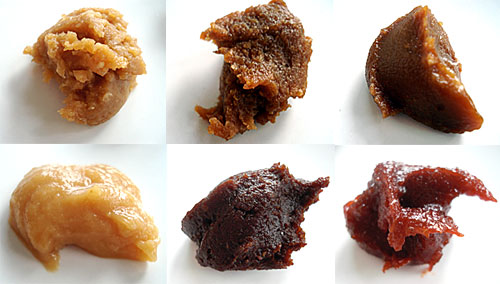
The top row shows the three misos I use the most: two types of shiromiso, and an awasemiso. One shiromiso is a big chunkier in texture and has brown rice in it; the other shiromiso and the awasemiso are both all-soy bean types. I use any of the three for most if not all the recipes here on Just Hungry or over on Just Bento. There's no good reason for me to have two shiromisos and an awasemiso - I just like trying out stuff.
The second row shows misos I use a lot less. On the left is a Saikyo miso, and in the middle is some quite salty-strong akamiso. I use Saikyo miso in some baking experiments and as a sauce to go with stewed daikon radish and such. The red miso is used for some marinades and some miso soups.
Lastly, since I had a square to fill and I only have 5 kinds of miso on hand at the moment, I've included some Korean gochujang (or kochujang as it's pronounced in Japan), although it's not a miso at all. It is however a fermented soy bean paste with added wheat, spices and so on.As you can see much redder than the 'red' akamiso - since I use it almost as much as miso because I love it so much.
The basics of Japanese cooking and all that
What actually prompted me to finally post this was an article I saw elsewhere that was titled What Is Miso Paste? It stated that miso and rice for Japanese people are like 'meat and potatoes for Americans'. Heh?
Sure, miso is part of Japanese cuisine. But you do not always eat miso, or always have miso soup, with a meal, if that was the analogy they were trying to use. Sure, soup is often served with a meal in Japan, but it can just as well be a clear soup as a miso soup. The real basis of Japanese cooking is rice, dashi and _sa shi su se so_. If you whittle it down to the bare essentials, a bowl of plain, white rice and something salty to go with it makes me feel Japanese through and through.
But enough of my whinging. If you have any questions about miso that I haven't answered here, ask away!
See also
- Japanese Basics: Miso and Miso Soup
- A week of miso soup, day 1, day 2, day 3, day 4, day 5, and wrapup
- Make your own instant miso soup balls
- Miso marinade for meat or fish
- All entries filed under miso on Just Hungry and Just Bento (also try the search function on the site since I may haved missed correctly tagging some miso posts!)